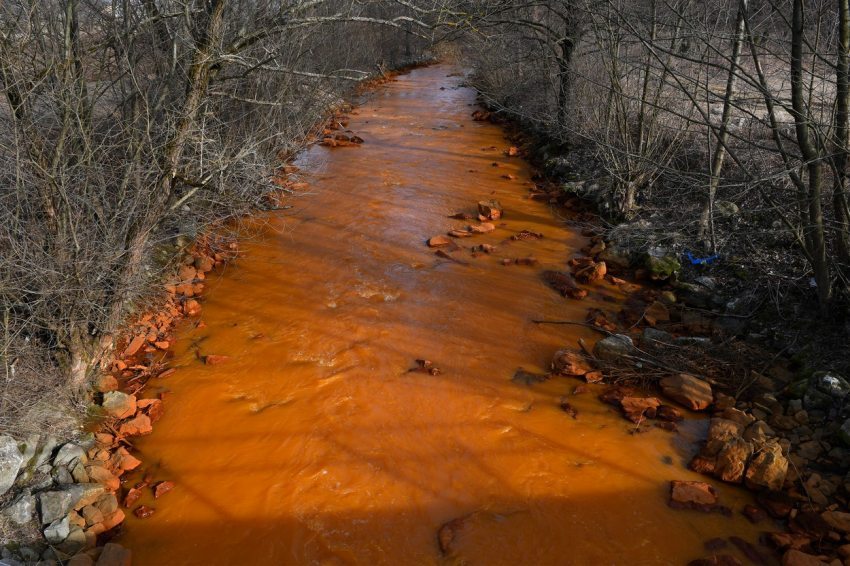Biologists and all nature-loving people may weep: iron-containing wastewater has been flowing into the River Sajó for several months
The River Sajó, which is even praised by Gyula Juhász in one of his poems, springs from the Gömör-Szepesi mountain range in Slovakia and, enriched with more and more tributaries, flows towards Hungary, where it joins the River Tisza. But recently, something quite astonishing has happened to this beautiful river, something that has shocked even the experts: its color has turned red, trout and river crayfish have died out along its 30-kilometer stretch, and its ecosystem is now - it can be said - dead. Iron-rich sewage has been pouring into it for months from the former Siderit plant site, and although the disaster was foreseeable, Slovak agencies and ministries have done nothing and are still pointing fingers at each other. The Hungarian section is still below the health limit, but it is possible that the situation could get worse.

Örs Orosz, MP of Nitra County, activist for rights in the Highlands (Felvidék), and co-founder of the Összefogás (Alliance) Movement drew attention to the problem on Facebook on 13 March 2022, posting photos and videos of the situation. In his post, he explained that the presence of zinc in the direct outflow was already in February a hundred times higher than the lethal dose for the river's wildlife, so the disaster was foreseeable.
Three tonnes of iron flow into the 223-kilometer-long Sajó every day (the Hungarian section of the river is 124 kilometers long!), precipitating in the form of iron hydroxide or rust.
In addition to arsenic, zinc, and iron, manganese and other elements are well above the maximum permitted levels. Örs Orosz wrote a letter to Minister Ján Budaj asking him to start dealing with the disaster immediately but received no reply.
In early April, the Slovak Water Management Company started work to reduce surface water seepage into the mine, and the mine rescue service also started work directly in the mine. They have been trying - so far without much success - to prevent water from seeping from the upper levels into the contaminated lower layers and to avoid contaminated water flowing to the surface.
Residents in the area continue to express their outrage on social media:
"I live in Slovakia and it's very sad to see that no one is doing anything. It is sad to see the destruction," writes one woman.
"Protecting our ecosystem is a priority as it affects our quality of life. Where is the Slovak Ministry of Environment and Water?! It is their job to stop the pollution and clean up the zinc deposits!" - a man posted his opinion.
It also causes slow agony for fish
The local anglers' representative and member of the local anglers' association, Tibor Varga, is taking the matter to the European Commission because he is deeply outraged that the government cannot be counted on in this situation.
"The problem is really deep. On this thirty-kilometer stretch, the Sajó is dead water."
"I haven't seen a single fish or arthropod, i.e. river crayfish or crab larvae. The trout, the chubs, and the graylings have died. If it's not the zinc, it's the iron hydroxide that kills them, which precipitates on the inside of their gills and leads to their slow agonizing death, they simply drown. At the moment there is no life under the rocks either, and until the arthropods that the fish feed on return, it is pointless to reintroduce the fish," he said.
According to Dr Balázs Lukács, biologist, Tisza researcher, and head of the Ecological Research Centre, in addition to the huge amount of iron, several other heavy metals have also been released into the water, but we do not have precise information about their quantity. Iron is not toxic in itself, but in a natural environment, when exposed to oxygen, it is converted into water-insoluble iron hydroxide and precipitates. If it precipitates in large quantities, it can cause problems, blocking light to plants and algae, and can be lethal if it enters the respiratory system of aquatic organisms. Living organisms that can move faster can avoid this. It would be advisable to use some kind of chemical to precipitate the toxic substance from the river to produce a salt compound. This is what was done in the red mud disaster - lime was used. But in natural waters, it is difficult to deal with this type of pollution because extra substances have to be added to the water to precipitate or dissolve the compounds, the amount of these is difficult to calculate and the resulting compound can be toxic to aquatic life.
"The amount of contaminated water that would need to be filtered in the 30-kilometer stretch in question is so large that it is technically impossible to do, and the ongoing filtration and remediation of this amount could cost hundreds of thousands of euros per month, and it is difficult to predict how successful it will be. This is why it is important to eliminate the source of pollution itself. However, there are and will be sections of the River Sajó where pollution cannot reach. From these intact sections, life will be able to regenerate in a few years," the expert reassures.
Hungary has repeatedly asked Slovakia to settle the situation
Our country was first officially informed by Örs Orosz through the consulate in Kassa, and Hungary has repeatedly asked Slovakia to settle the situation.
If the pollution is not stopped soon, the contaminated sediment will reach the Hungarian section of the Sajó, damaging the wildlife of the Hungarian section of the river.
It's almost June and still, no real progress has been made, the Slovak authorities are still inactive. Despite the fact that the mine in question is in state hands, the Ministry of Nature Conservation is pointing the finger at the Ministry of Economy and vice versa.
Dr. Balázs Lukács believes that although this pollution would require immediate intervention in the given section, there is no reason for excessive concern in Hungary for the time being, because in recent months, by the time the waters of the Sajó reached Hungary, the contaminated sediment had been diluted and naturally cleaned, so the level of pollution has not yet reached the health limit. "This will remain the case as long as there is sufficient rainfall in the coming weeks and months. If there is not, and therefore the volume of water in the Sajó is reduced, then unfortunately the polluted water will reach the Hungarian stretch in a more concentrated form, and a scenario could occur where action is needed to save aquatic life. But the chances of this happening are minimal."







